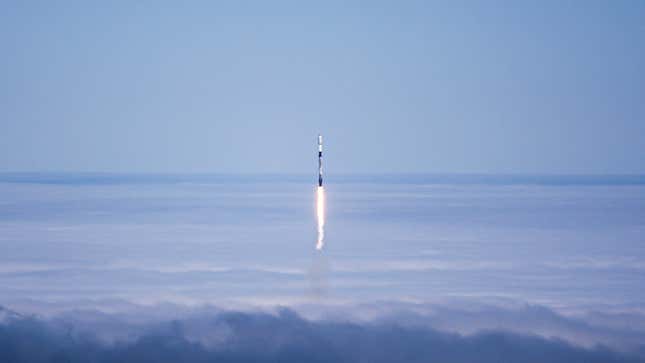
South Korea is embarking on its first lunar mission, and SpaceX has been brought in to help. You can catch this historic launch live right here.
Hard to believe, but the upcoming launch marks the first time that SpaceX will directly send a payload to a ballistic lunar transfer orbit. And as for South Korea, this marks its first mission to the Moon, adding itself (fingers crossed) to a very small list of nations to do so.
The payload du jour is the Korea Pathfinder Lunar Orbiter (KPLO), also known as Danuri, in a mission managed by the Korea Aerospace Research Institute (KARI). SpaceX’s Falcon 9 rocket is scheduled to launch from Space Launch Complex 40 at Cape Canaveral Space Force Station, Florida, at 7:08 p.m. ET. Live coverage will begin 15 minutes prior to launch, which you can watch at SpaceX or at the feed provided below.
To be fair, SpaceX has sent an object to the Moon before, namely Israel’s Beresheet Moon lander (which crashed on the lunar surface in 2019), but that was done as part of a routine Falcon 9 rideshare mission to a geosynchronous transfer orbit around Earth. Once in space, Beresheet used its own power to gradually raise its altitude, eventually entering into its lunar orbit (and the mission failure had nothing to do with SpaceX). In addition, the private company has previously sent objects deep into the solar system, including a red Tesla Roadster, but never before has it sent something directly to our beloved Moon.
That’s set to change today. SpaceX is reporting an 80% chance of favorable weather. Should the launch have to be scrubbed, the company will try again tomorrow at 7:00 p.m. ET.
Following stage separation, the first stage will attempt a landing on the Just Read the Instructions droneship, currently stationed in the Atlantic Ocean. This particular booster has already performed several successful landings. Once in space and at roughly 34 minutes into the mission, the second stage will perform a re-start, with the engine cutting off when the mission clock reaches 35:15. Danuri will deploy and begin its journey to the Moon five minutes later.

The 1,100-pound (500-kilogram) probe will enter into a lunar polar orbit in mid-December, where it will operate 60 miles (100 kilometers) above the surface for at least one year. Should the mission be extended, KPLO will drop to an orbit that’s 43 miles (70 km) above the Moon. A post from Teslarati explains why it’s going to take so long for Danuri to reach its target orbit:
Instead of launching the satellite as a rideshare payload to an Earth orbit, KPLO...will be the only spacecraft aboard Falcon 9, and the SpaceX rocket will directly send the orbiter on a type of trans-lunar injection (TLI) trajectory known as a Ballistic Lunar Transfer. A BLT is much slower than some alternative TLI trajectories, but it trades speed for exceptional efficiency, making the launch easier for Falcon 9 and ultimately giving the orbiter more useful time around the Moon by requiring less propellant to enter orbit.
The primary goals of the mission are to “develop indigenous lunar exploration technologies, demonstrate a ‘space internet’, and conduct scientific investigations of the lunar environment, topography, and resources, as well as identify potential landing sites for future missions,” according to NASA. The space agency provided a high-sensitivity camera for the mission, with South Korea developing its four other instruments: a lunar terrain imager, a wide-angle polarimetric camera (dubbed the PolCam), a magnetometer, and a gamma-ray spectrometer. Combined, these five devices weigh no more than 88 pounds (40 kg).
A contingent of NASA-sponsored scientists will participate in the analysis of the incoming mission data. Using the PolCam, scientists with the Space Science Institute in Boulder, Colorado, will study lunar pyroclastic deposits—ash deposits that formed long ago in the wake of violent volcanic eruptions. “Such ash deposits can be sourced from deep in the lunar interior and can contain volatile materials including water,” according to an emailed SSI statement. “They thus have the potential for providing information on the nature of the lunar interior and represent a potential resource for future human use of lunar resources.”
We wish the best of luck to South Korea on this important mission, as yet another nation looks to establish a presence around the Moon.
More: These Failed Missions to the Moon Remind Us That Space Is Hard.